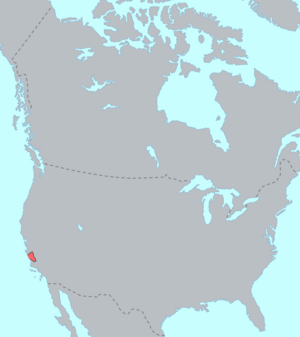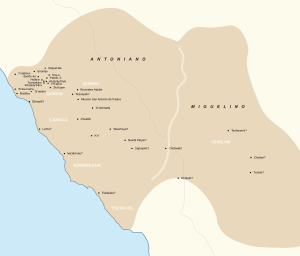Salinan facts for kids
| Te'po'ta'ahl | |
|---|---|

Miguelino family near
Mission San Antonio de Padua |
|
| Total population | |
| 681 (2000, census) | |
| Regions with significant populations | |
| Languages | |
| English, formerly Salinan | |
| Religion | |
| Salinan traditional narratives |
The Salinan are an Native American group from the beautiful Central Coast of California. Their homeland was in the southern Salinas Valley and the Santa Lucia Range. They spoke a special language called Salinan, which was unique and not clearly related to other languages.
Contents
Exploring the Salinan Homeland
The Salinan people lived in different groups across their land. There were two main groups and one smaller one. The Antoniano group lived in the northern part of the Salinas Valley. They were near where two Spanish missions, Mission San Antonio de Padua and Mission San Miguel Arcángel, were later built.
The Miguelino group lived further south, along the upper Salinas River. Their territory included areas near Slates Hot Springs and Junipero Serra Peak. A smaller group, the Playano, lived right on the Pacific Coast. They were near places like Lucia and San Simeon today.
The Salinan people were Hunter-gatherers. This means they found their food by hunting animals and gathering plants. Like many other California tribes, they lived in small communities. These groups usually had simple leadership structures.
Daily Life and Food Sources
Evidence shows that many Salinan people lived along the coast. They left behind large piles of shells, called middens. These shell piles tell us about their diet. During the summer, they ate a lot of fish and shellfish. You can still find tiny shell pieces in the soil where they once camped.
The Salinan people had their own names for important places. For example, they called a significant peak Pimkolam.
Ancient Homes at Wagon Caves
A special place called Wagon Caves is located near Jolon. This rock formation covers about 56 acres. It was an important archaeological site for the Salinan Antonianos group. Experts believe they had at least two villages here.
One village dates back to around 450 A.D. Another, more recent village, was used between 1450 and 1650 A.D. Archaeologists have discovered many items at Wagon Caves. These include stone tools, shell beads, and animal bones. They also found charred seeds and grinding stones called mortars.
The caves and rock shelters show signs of human activity for hundreds of years. Their roofs are darkened by smoke from countless fires. The larger Wagon Cave Research Natural Area protects 806 acres of land. It is home to many different Valley Oak trees.
What Does "Salinan" Mean?
The name "Salinan" comes from the Salinas River. Spanish explorers gave them this name. They did not know what the people called themselves. However, the Salinan people had their own name for themselves. It meant "People of the Oaks."
A researcher named C. Hart Merriam learned another name for them. He called them En-'ne-sen. This was the Native word for their main gathering place. Merriam thought the name "Salinan" might have come from e'n-ne-sen.
The Unique Salinan Language
The Salinan language is very special. It is known as a language isolate. This means it is not clearly related to other languages. Some experts have suggested it might be part of the Hokan language family. However, there is not strong proof for this idea.
The Salinan language was spoken by the people for many centuries. Sadly, the last known speakers passed away in the 1950s. Today, efforts are being made to learn more about and preserve this important language.
How Many Salinan People Lived?
It is hard to know exactly how many Salinan people lived long ago. Before Europeans arrived, estimates vary greatly. One expert, Alfred L. Kroeber, thought there were about 3,000 Salinan people in 1770. Another researcher, Sherburne F. Cook, estimated at least 700.
More recently, the 2000 United States census counted 681 people who identified as Salinan. This shows that the Salinan people continue to be an important part of California's history and present.
See also
- Salinan traditional narratives
- Kuksu (religion)
- Painted Rock (San Luis Obispo County)
- Chalon
- USS Salinan (ATF-161)



